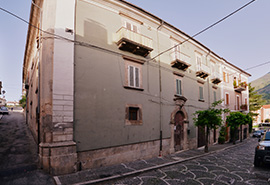When in 1831 the botanist Giuseppe Tenore from Naples paid a visit to Palena, he was struck not only by the extraordinary environmental and landscape heritage of the area but also by the buildings (amongst which detected many incospicuous buildings of the most wealthy citizens). The botanist then mention those residences that the nobility of palena had been able to build with the proceeds of the wool industry, flourishing in the village until after the XIX century . It was about these families who had found an important source of wealth in transforming wool into cloth and then putting it on the market. The buildings in which they lived in were the mirror of what had been accumulated.
The history of the Magadonna building, in Via IV Novembre, is told in a tone somewhere between ironic and grotesque, by Ettore Margadonna, writer and screenwriter of the most famous movie of the '60s and in the novel 'The Asinaccia' included in the collection 'God sows men'.
The building was constructed on the site of the ancient church of San Rocco, where, during the middle ages, were buried the dead. Margadonna tells, that in the excavation of the foundations many bones were found and that this caused the foreman to translocate all the remains to the small village cemetery. The premises for the construction of the building were thus quite complex: the building had to be built above the void left by the excavation of the communal grave; to overcome this problem they had to build high compact walls at the two entrances - one on the road and one on the opposite side - for this reason there are no windows to the first floor.
They made a large ladder to climb from street level to the next floor, where, however, some of the rooms were not equipped with windows to reinforce the stability of the building. Ettore Margadonna tells the whole story with the tones of his own narrative, funny and irreverent.
Even today, on the elegant doorway there is fixed the scroll with the two letters G and M, certainly the initials of the owner of the building and who Margadonna imaginatively calls Vitantonio in his narrative.

When in 1831 the botanist Giuseppe Tenore from Naples paid a visit to Palena, he was struck not only by the extraordinary environmental and landscape heritage of the area but also by the buildings (amongst which detected many incospicuous buildings of the most wealthy citizens). The botanist then mention those residences that the nobility of palena had been able to build with the proceeds of the wool industry, flourishing in the village until after the XIX century . It was about these families who had found an important source of wealth in transforming wool into cloth and then putting it on the market. The buildings in which they lived in were the mirror of what had been accumulated.
The history of the Magadonna building, in Via IV Novembre, is told in a tone somewhere between ironic and grotesque, by Ettore Margadonna, writer and screenwriter of the most famous movie of the '60s and in the novel 'The Asinaccia' included in the collection 'God sows men'.
The building was constructed on the site of the ancient church of San Rocco, where, during the middle ages, were buried the dead. Margadonna tells, that in the excavation of the foundations many bones were found and that this caused the foreman to translocate all the remains to the small village cemetery. The premises for the construction of the building were thus quite complex: the building had to be built above the void left by the excavation of the communal grave; to overcome this problem they had to build high compact walls at the two entrances - one on the road and one on the opposite side - for this reason there are no windows to the first floor.
They made a large ladder to climb from street level to the next floor, where, however, some of the rooms were not equipped with windows to reinforce the stability of the building. Ettore Margadonna tells the whole story with the tones of his own narrative, funny and irreverent.
Even today, on the elegant doorway there is fixed the scroll with the two letters G and M, certainly the initials of the owner of the building and who Margadonna imaginatively calls Vitantonio in his narrative.











